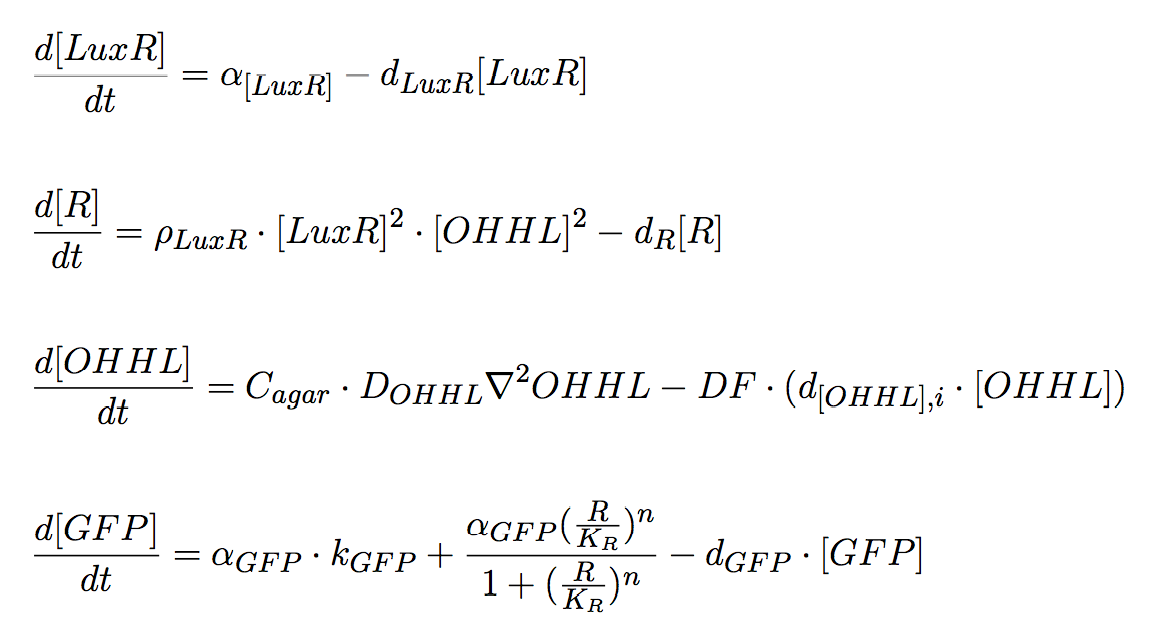Team:ETH Zurich/GFP
From 2013.igem.org
| Line 43: | Line 43: | ||
<h1>Receiver Cells </h1> | <h1>Receiver Cells </h1> | ||
| - | Receiver Cells are responsible for processing the signal sent by the mine cells. The input is the signalling molecule, AHL, and the output is a fluorescence signal whose intensity correlates with the sensed AHL concentration; for this purpose GFP expression is under control of P<sub>lux</sub> promoter. Once AHL reaches a non-mine colony, it can bind to LuxR protein, and the complex LuxR/AHL acts as a transcriptional activator. Therefor, this module acts as a high pass amplitude filter for GFP, since it is produced when the AHL levels are sufficiently high <br><br> | + | Receiver Cells are responsible for processing the signal sent by the mine cells. The input is the signalling molecule, AHL, and the output is a fluorescence signal whose intensity correlates with the sensed AHL concentration; for this purpose GFP expression is under control of P<sub>lux</sub> promoter. Once AHL reaches a non-mine colony, it can bind to LuxR protein, and the complex LuxR/AHL acts as a transcriptional activator. Therefor, this module acts as a high pass amplitude filter for GFP, since it is produced when the AHL |
| + | |||
| + | [[File:receiver_GFP.png|500px|center|thumb|<b>Figure 5: Differential equations of the receiver cells</b>]]levels are sufficiently high <br><br> | ||
Revision as of 20:10, 16 September 2013
Contents |
Reaction-Diffusion Model: genetic circuit with GFP as reporter gene
In our first spatio-temporal model, we wanted to find out if (i) a suitable AHL gradient forms at all and (ii) validate the model with experimental data. Essentially we model the receiver cells (E. coli DH5α strain) being transformed with a plasmid containing GFP under the control of pLux promoter. Subsequently, we simulate a 2D spatio-temporal reaction-diffussion system with COMSOL Multiphysics.
AHL: Reaction-Diffusion Equation
The change of AHL concentration over time is influenced by two processes: (i) local chemical reactions and (ii) diffusion; which causes the molecule to spread over the agar plate (Eq. 1).
For diffusion, we have a partial differential equation (Eq. 2) which describes density fluctuations over time and space. We don't model AHL diffusion into and out cells explicitly; the underlying assumption is that this process is fast. From equation 2, DAHL(AHL(r,t),r) denotes the collective diffusion coefficient for AHL at location r. However, we assume that the diffusion coefficient does not depend on the density, i.e., DAHL is a constant. The value reported in the literature for the diffusion constant corresponds to measurements performed in water at 25oC. Since diffusion in our system happens in agar, we scaled the diffusion constant by a factor Cagar (Fatin-Rouge et al., 2004).
For the reaction component, the change of AHL concentrations over time is given by an ordinary differential equation (ODE), that comprises production and linear degradation. The synthesis of the signalling molecule depends on the product of luxI gene. Now for the degradation, we consider that AHL degrades at different rates depending on the localization, i.e. cytoplasmic or extracellular. Given that the intracellular degradation is driven by enzymatic degradation, whereas the extracellular decay is a non active process. Our model also includes a dilution factor due to the cell growth (Eq. 3).
Finally, we need to specify the initial conditions (at time t = 0) and boundary conditions. At the starting point there is no AHL in the agar plate, thus the initial concentration is zero ([AHL(r,t=0)] = 0 M). For the boundary condition, we take into account that there is not flux out of the agar plate.
ODE's for other species
AHL is the only species in the model that is diffusing in and out cells, hence the change of the other species concentrations over time is given by system of non-linear ordinary differential equations (ODEs), following Michaelis-Menten kinetics. Our system consists of two type of genetically engineered colonies: (i) Mine Cells and (ii) Receiver Cells, that can be treated as modules and communicate only by a single molecule, AHL.
Mine Cells
Two proteins of interest for our design are produced by mine cells: (i) LuxI and (ii) NagZ. In both cases, the genes are expressed under constitutive promoters. Aditionally, the synthesis of AHL is carried on by mine cells; specifically, the product of luxI gene is directly involved in the synthesis of the molecule, using as substrates S-adenosylmethionine (SAM) and an acylated acyl carrier protein (ACP) from the fatty acid biosynthesis pathway (Schaefer et al., 1996). We assume precursor molecules are provided by the cell in non-limiting conditions.
The PDEs for the states involved in the sender module are given below:
Receiver Cells
Receiver Cells are responsible for processing the signal sent by the mine cells. The input is the signalling molecule, AHL, and the output is a fluorescence signal whose intensity correlates with the sensed AHL concentration; for this purpose GFP expression is under control of Plux promoter. Once AHL reaches a non-mine colony, it can bind to LuxR protein, and the complex LuxR/AHL acts as a transcriptional activator. Therefor, this module acts as a high pass amplitude filter for GFP, since it is produced when the AHL
levels are sufficiently high
Results: Simulation
 "
"











